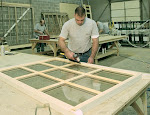What many of our customers don’t know is that the ownership of Re-View cut our teeth in the window business by selling and installing aluminum clad wood windows. We have installed thousands of windows manufactured by the largest window manufacturers in the world, including Andersen, Pella, Marvin, Eagle, and Weather Shield. Over the past five years, these manufacturers have made significant efforts to market their products as replacements for historic wood windows. Designers who are attracted to the prospect of low maintenance and energy efficiency are buying the message and specifying aluminum clad wood windows as replacements for wood windows that have lasted for 100+ years. Unfortunately, there is a serious problems with using aluminum clad wood window replacements in historic applications.
The big selling point for the aluminum clad wood window manufacturers is the concept of a low maintenance exterior. Clad windows are designed with an exterior skin of aluminum applied to the exposed sash and frame parts that has a baked on finish applied at the factory. The manufacturers use either roll-formed cladding or extruded cladding on their windows. Roll formed cladding is very thin which makes it easy to bend and form into tight shapes and profiles. It is less expensive than extruded aluminum since the material is so thin. Extruded aluminum, on the other hand, is much thicker and must be extruded through a die to create a desired shape. Extruded cladding is more impervious to denting than roll formed cladding. The cladding is typically connected to the wood through a clip system or other mechanical methods.
The marketing tune played by the large manufacturers includes never having to paint your windows again. This is a very attractive message for schools, courthouses, and offices that don’t have annual maintenance budgets for finishing. Unfortunately, most of the major manufacturers have catastrophic errors in their cladding and sash designs that seriously limit their life expectancy. You may not have to ever paint the aluminum clad wood window, but you will have to replace it within a 10-30 year timeframe.
The cladding on the sash of most of the window manufacturers is sealed to the glass with either a glazing tape or butyl sealant. Both of these methods have a 10-year life span at best so at some point, water is going to penetrate this seal. Many of the manufacturers recommend applying a cap bead of silicone to the sash to prevent leaks. Unfortunately, none of the major wood window manufacturers incorporate water management into their designs. The glazing pocket is typically unfinished wood that has only been surface treated with a wood preservative. There are no weep holes built into the glazing pocket to allow water to escape. Once water breaches the main seal, it will be contained within its built-in sarcophagus, accelerating the wood rot process. This major design defect is the primary reason the wood window industry is under attack. Just get on Google and type in “class action lawsuit against wood window manufacturers” and you will see what I mean about the wholesale wood rot epidemic eating at the heart of the industry. These wood rot problems have also fueled the growth of aluminum, vinyl, and fiberglass window alternatives.
Another problem with aluminum clad wood windows is how the sash design does not allow for replacing the glass. Although there have been outstanding quality developments in insulated glass technology over the past ten years, you can be fairly certain that the seal will break sometime within the first 30 years. The clad wood window manufactures build the sash around the glass making it virtually impossible to replace the glazing. The main reason these manufacturers do not incorporate a reglazing feature in their designs is that the glass provides much of the structural integrity of the sash. Once the glass breaks or fails, the entire sash must be replaced. Since these companies change the designs of their window products approximately every five years, the entire window will have to be replaced if the design is obsolete. It is almost like the major wood window manufacturers have built in a mandatory replacement mechanism to help sustain their business model into the future.
When one looks at the epidemic levels of wood rot for aluminum clad wood windows and the inability to replace glass on these windows, it is obvious that replacing a 100 year old wood window is not be the best course of action.
You can access our Facebook page to see pictures of these clad wood window designs and resulting problems.
https://www.facebook.com/media/set/?set=a.386861071369906.89473.118211914901491&type=1#!/media/set/?set=a.386861071369906.89473.118211914901491&type=1
Tuesday, July 10, 2012
Subscribe to:
Comments (Atom)





